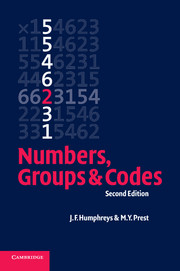Book contents
- Frontmatter
- Contents
- Preface to first edition
- Preface to second edition
- Introduction
- Advice to the reader
- 1 Number theory
- 2 Sets, functions and relations
- 3 Logic and mathematical argument
- 4 Examples of groups
- 5 Group theory and error-correcting codes
- 6 Polynomials
- Appendix on complex numbers
- Answers
- References and further reading
- Biography
- Name index
- Subject index
Introduction
Published online by Cambridge University Press: 05 September 2012
- Frontmatter
- Contents
- Preface to first edition
- Preface to second edition
- Introduction
- Advice to the reader
- 1 Number theory
- 2 Sets, functions and relations
- 3 Logic and mathematical argument
- 4 Examples of groups
- 5 Group theory and error-correcting codes
- 6 Polynomials
- Appendix on complex numbers
- Answers
- References and further reading
- Biography
- Name index
- Subject index
Summary
‘A group is a set endowed with a specified binary operation which is associative and for which there exist an identity element and inverses.’ This, in effect, is how many books on group theory begin. Yet this tells us little about groups or why we should study them. In fact, the concept of a group evolved from examples in number theory, algebra and geometry and it has applications in many contexts. Our presentation of group theory in this book reflects to some extent the historical development of the subject. Indeed, the formal definition of an abstract group does not occur until the fourth chapter. We believe that, apart from being more ‘honest’ than the usual presentation, this approach has definite pedagogic advantages. In particular, the student is not presented with a seemingly unmotivated abstract definition but, rather, sees the sense of the definition in terms of the previously introduced special cases. Moreover, the student will realise that these concepts, which may be so glibly presented, actually evolved slowly over a period of time.
The choice of topics in the book is motivated by the wish to provide a sound, rigorous and historically based introduction to group theory. In the sense that complete proofs are given of the results, we do not depart from tradition. We have, however, tried to avoid the dryness frequently associated with a rigorous approach.
- Type
- Chapter
- Information
- Numbers, Groups and Codes , pp. xi - xiiiPublisher: Cambridge University PressPrint publication year: 2004

